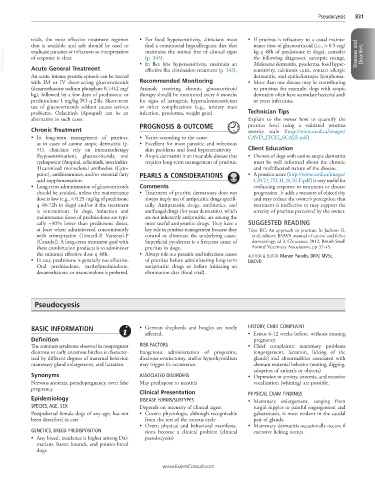Page 1655 - Cote clinical veterinary advisor dogs and cats 4th
P. 1655
Pseudocyesis 831
trials, the most effective treatment regimen • For food hypersensitivity, clinicians must • If pruritus is refractory to a usual mainte-
that is available and safe should be used to find a commercial hypoallergenic diet that nance dose of glucocorticoid (i.e., > 0.5 mg/
VetBooks.ir of response is clear. • In flea bite hypersensitivity, maintain an the following diagnoses: sarcoptic mange, Diseases and Disorders
kg q 48h of prednisone in dogs), consider
maintains the animal free of clinical signs
eradicate parasites or infections so interpretation
(p. 345).
Malassezia dermatitis, pyoderma, food hyper-
Acute General Treatment
An acute, intense pruritic episode can be treated effective flea elimination treatment (p. 342). sensitivity, calcinosis cutis, contact allergic
dermatitis, and epitheliotropic lymphoma.
with IM or IV short-acting glucocorticoids Recommended Monitoring • More than one disease may be contributing
(dexamethasone sodium phosphate 0.1-0.2 mg/ Animals receiving chronic glucocorticoid to pruritus; for example, dogs with atopic
kg), followed by a few days of prednisone or therapy should be monitored every 6 months dermatitis often have secondary bacterial and/
prednisolone 1 mg/kg PO q 24h. Short-term for signs of iatrogenic hyperadrenocorticism or yeast infections.
use of glucocorticoids seldom causes serious or other complications (e.g., urinary tract
problems. Oclacitinb (Apoquel) can be an infection, pyoderma, weight gain). Technician Tips
alternative in such cases. Explain to the owner how to quantify the
PROGNOSIS & OUTCOME pruritus level using a validated pruritus
Chronic Treatment severity scale (http://www.cavd.ca/images/
• In long-term management of pruritus, • Varies according to the cause CAVD_ITCH_SCALE.pdf).
as in cases of canine atopic dermatitis (p. • Excellent for most parasitic and infectious
91), clinicians rely on immunotherapy skin problems and food hypersensitivity Client Education
(hyposensitization), glucocorticoids, oral • Atopic dermatitis is an incurable disease that • Owners of dogs with canine atopic dermatitis
cyclosporine (Atopica), oclacitinib, interleukin- requires long-term management of pruritus. must be well informed about the chronic
31caninized monoclonal antibodies (Cyto- and multifaceted nature of the disease.
point), antihistamines, and/or essential fatty PEARLS & CONSIDERATIONS • A pruritus score (http://www.cavd.ca/images/
acid supplementation. CAVD_ITCH_SCALE.pdf) is very useful for
• Long-term administration of glucocorticoids Comments evaluating response to treatment or disease
should be avoided, unless the maintenance • Treatment of pruritic dermatoses does not progression. It adds a measure of objectivity
dose is low (e.g., < 0.25 mg/kg of prednisone always imply use of antipruritic drugs specifi- and may reduce the owner’s perception that
q 48-72h in dogs) and/or if the treatment cally. Antiparasitic drugs, antibiotics, and treatment is ineffective or may support the
is intermittent. In dogs, induction and antifungal drugs (for yeast dermatitis), which severity of pruritus perceived by the owner.
maintenance doses of prednisolone are typi- are not inherently antipruritic, are among the
cally ≈30% lower than prednisone doses, most useful antipruritic drugs. They have a SUGGESTED READING
at least when administered concomitantly key role in pruritus management because they Tater KC: An approach to pruritus. In Jackson H,
with trimeprazine (Temaril-P, Vanectyl-P control or eliminate the underlying cause. et al, editors: BSAVA manual of canine and feline
[Canada]). A long-term treatment goal with Superficial pyoderma is a frequent cause of dermatology, ed 3, Gloucester, 2012, British Small
these combination products is to administer pruritus in dogs. Animal Veterinary Association, pp 37-45.
the minimal effective dose q 48h. • Always rule out parasitic and infectious causes AUTHOR & EDITOR: Manon Paradis, DMV, MVSc,
• In cats, prednisone is generally not effective. of pruritus before administering long-term DACVD
Oral prednisolone, methylprednisolone, antipruritic drugs or before initiating an
dexamethasone, or triamcinolone is preferred. elimination diet (food trial).
Pseudocyesis
BASIC INFORMATION • German shepherds and beagles are rarely HISTORY, CHIEF COMPLAINT
affected. • Estrus 6-12 weeks before, without ensuing
Definition pregnancy
The common syndrome observed in nonpregnant RISK FACTORS • Chief complaints: mammary problems
diestrous or early anestrous bitches is character- Exogenous administration of progestins, (engorgement, lactation, licking of the
ized by different degrees of maternal behavior, diestrous ovariectomy, and/or hypothyroidism glands) and abnormalities associated with
mammary gland enlargement, and lactation. may trigger its occurrence. aberrant maternal behavior (nesting, digging,
adoption of animals or objects)
Synonyms ASSOCIATED DISORDERS • Depression or anxiety, anorexia, and excessive
Nervous anorexia, pseudopregnancy, overt false May predispose to mastitis vocalization (whining) are possible.
pregnancy
Clinical Presentation PHYSICAL EXAM FINDINGS
Epidemiology DISEASE FORMS/SUBTYPES • Mammary enlargement, ranging from
SPECIES, AGE, SEX Depends on intensity of clinical signs: turgid nipples to painful engorgement and
Postpubertal female dogs of any age; has not • Covert: physiologic, although recognizable galactostasis, is most evident in the caudal
been described in cats from the rest of the estrous cycle pair of glands.
• Overt: physical and behavioral manifesta- • Mammary dermatitis occasionally occurs if
GENETICS, BREED PREDISPOSITION tions become a clinical problem (clinical excessive licking occurs.
• Any breed; incidence is higher among Dal- pseudocyesis)
matians, basset hounds, and pointer-breed
dogs.
www.ExpertConsult.com

